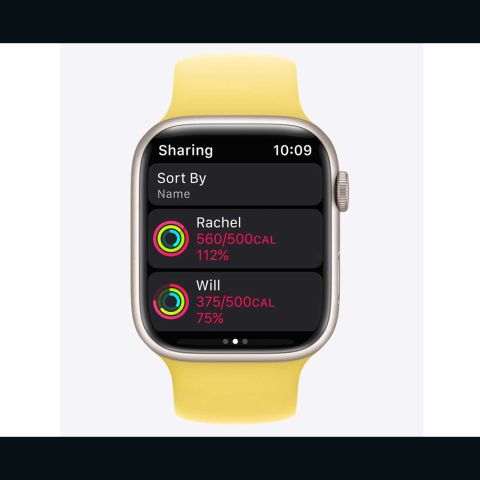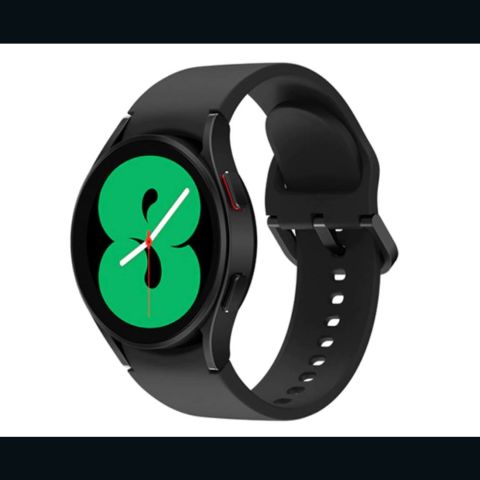Though Fitbit and Apple are two of the most prominent players when it comes to fitness trackers and smartwatches, Garmin, which has been around since 1989 and makes a host of high-end activity trackers, is still in the game. I took a look at its latest active lifestyle fitness tracker/smartwatch, the Venu 2 Plus, to see how it stacks up as a workout buddy.
I’ll confess, I’m generally on #TeamApple when it comes to personal tech. I’ve bought into the ecosystem 100%. But I thought it was time to find out what life was like outside the infinite loop of the Appleverse, so the Venu 2 Plus was the first stop on that journey.
If you’re not tied to a specific phone ecosystem and want a tracker that will record almost anything you do that burns calories, the $449 Venu 2 Plus has a lot to offer. But given its overly-complex interface and smartwatch functionality, most people are better off with an Apple Watch, Galaxy Watch or Fitbit.
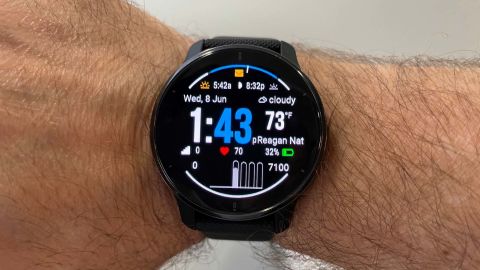
The Venu 2 Plus, Garmin’s upscale offering, looks good. It successfully combines the style of a smartwatch with the toughness and long battery life of a sports tracker. I tested a stainless steel black model with a fantastic OLED display with deep blacks and vibrant colors, which especially helped me see it clearly on a bright, sunny day.
The Venu 2 Plus is 43.6mm in diameter with a 33mm screen and stainless steel back cover. It weighs 51 grams, making it quite a bit heavier than the aluminum Apple Watch 7 (38.8 grams). While in smartwatch mode, which means not using GPS to track workouts, Garmin says the Venu 2 Plus will last up to nine days on a full battery. I found this to be pretty accurate.
Overall, the watch is sleek and sexy, and if it weren’t for the silicone strap, you could wear this in a formal setting. (In fairness, you can change the bands. I’d recommend the Ritche Quick Release Leather Watch Band or a Ldfas steel link band if you want to get fancy.)
In addition to the touchscreen, the 2 Plus has three buttons. The top button starts and stops activities, and holding it for 3 seconds brings up a screen of customized shortcuts. Hold it for more than that, and it will try to initiate an emergency call to first responders and any emergency contacts you set up. The bottom button takes you back to the previous screen but can double as a lap counter. Long pressing it gets you into settings. (More on that below.)
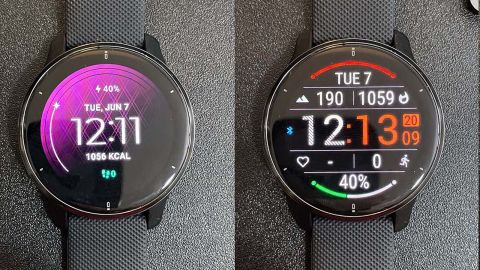
However, the biggest advantage the Venu 2 Plus has over previous Venu 2 models is its ability to connect to your phone, allowing you to make and receive phone calls and access your phone’s smart assistant (Siri, Google Assistant, or Samsung’s Bixby). This is the purpose of the middle button. Press this, and it triggers your phone’s assistant and plays any audio through the watch. I didn’t have an Android device to test it with, but using it with Siri was.… fine. But it doesn’t have the deep integration Siri has one the Apple platform, naturally.
The integration with your phone is good but breaks no new ground. In addition to the call features, which are pretty much table stakes these days, with an Android phone, you can also receive and reply to text messages with some simple pre-built answers, such as “Yes,” “No,” or “I’ll call you later.” That won’t work for iPhone users, however. Apple wants you to buy an Apple Watch, so it doesn’t allow third-party replies to text messages. That’s not Garmin’s fault, of course, but it limits functionality with iPhones.
It’s got a lot of sensors on it. GPS, barometer, compass, thermometer, gyroscope, accelerometer, ambient light, heart rate, and pulse oximeter are all there. This means it can track just about anything you do, and it supports some 25 activity types out of the box. (There are more than 1,400 additional activities available for download, too.) For some exercises like strength training and yoga, you can see helpful videos that show proper form right on the watch—but finding these little videos is a chore. For instance, to see the proper form video for the dumbbell fly exercise, I had to push a side button, swipe to the strength training section, then tap six times through a chain of icons to finally see the video.
One standout health tracking feature, however, is the Health Snapshot. This takes a two-minute reading of key health stats, including average heart rate, breathing, stress level, and heart rate variability. It also includes what Garmin calls Body Battery, an energy monitoring score that combines how sleep, stress, and exercise affect your readiness for training.
Speaking of battery, this thing won’t quit. Well, it will, but only after about 9 or 10 days, as Garmin promised. It also charges quickly. Once, I forgot to charge it and let it run all the way down to empty. It charged up to 60 percent in about 45 minutes and didn’t budge off that for much of the rest of the day.
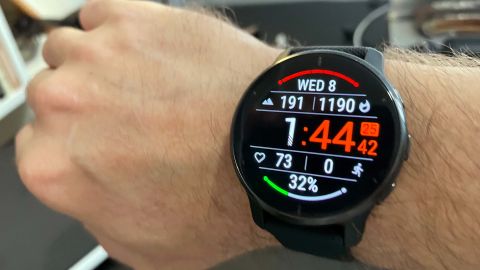
As with most fitness technology today, no gadget exists independently. It needs an app, probably a store of some kind to add new watch faces and activities, and some way to upgrade. Connection to a smartphone is de rigueur, as it’s still the best way to see and analyze the oceans of data these fitness trackers collect.
Unfortunately, the Garmin Connect app on the phone verges on incomprehensible, with many layers of hard-to-navigate nested menus. Altering basic settings was so non-intuitive that I had to Google how to change a watch face after I installed one and decided I didn’t like it. (You have to do it on the watch. You can’t change the watch face via the phone app like you can with an Apple Watch.) It’s confusing; some settings need to be done on the phone, and some need to be done on the watch itself. But there seems to be no real clue into which settings need to be changed where.
Navigating the Venu 2 Plus itself isn’t bad, per se, but compared to the fluid simplicity of the Apple Watch, there’s too much screen swiping, smashing buttons, and generally hunting for basic things like starting a workout. I was never quite sure if I was supposed to use the side buttons or the touchscreen. Often I tried both just to see what would happen. It was frustrating.
The app store for the device, accessed through the Garmin Connect IQ app, is worse. It seems to be even more of a free-for-all than the early Google Play Store, with many deeply complicated watch faces catering to fitness geeks who need data, data, and more data. I scuba dive and my dive computer has a simpler interface than some of these watch faces available. I just want to know how far I ran, how long it took me, and when I started and stopped. If I want more data, I want to look on the phone where it’s easier to find and interpret.
That’s not to say there aren’t basic watch faces, but those verge on the too simplistic with too little data. It’s tough to find the right balance.

The store also offers downloadable activities and a mish-mash of what Garmin calls “data fields” that mostly duplicate each others’ functions. Searching for anything specific is a chore, and the whole store could benefit from better categorization and polish. For instance, there’s no way to search just for a list of all the downloadable activities; you have to search for exactly what you’re looking for—kayaking, for instance—and get a host of irrelevant results for your trouble.
Finally, there are a lot of Russian and Chinese apps, watch faces, and data fields to download. Garmin is an international company and there are tons of legitimate coders in both countries who enjoy fitness and want to make a living selling the fruits for their skills. 99.9 percent are likely legit. But I couldn’t shake the feeling that there’s no real quality control in the Garmin app store and I found myself leery of installing stuff that might access my intimate location and health data. Call me paranoid, but this is the world we live in.
All in all, the software side of the watch is a shame. Much of this complexity and fiddliness exist because the Venu 2 Plus is, at heart, more of a fitness tracker than a smartwatch. On the Apple Watch, for example, there is some basic fitness functionality in its workout app, but it leaves the intensive data collection and demo videos to third-party developers like Smart Gym. The Venu 2 Plus doesn’t have the CPU oomph or the developer community to do this, however.
The Garmin Venu 2 Plus is a good-looking smartwatch/fitness tracker mashup that can go for days and record data on just about any activity you can imagine. But I’ll be honest: I’m not sure who this is for. Apple users will gravitate towards an Apple Watch. Android users may be a better fit for the Venu 2 Plus, but they can also opt for the excellent Galaxy Watch 4 or get a cheaper Fitbit Inspire 2. In the end, a fiddly interface, non-intuitive phone app, and a half-baked store hold it back from being one of the best smartwatches or best fitness trackers.
| Compatible phones | iPhone, Android | iPhone | Android |
|---|---|---|---|
| Size options | 40mm, 43mm, 45mm | 41mm, 45mm | 40mm, 44mm |
| Weight | 51 grams | 32 to 37 grams (41mm model);38.8 to 45.1 grams (45mm model) | 30.3 grams (44mm), 25.9 grams |
| Display | AMOLED, optional always-on mode | Always-on Retina LTPO OLED display | Always-on Super AMOLED display |
| Battery Life | Smartwatch mode: Up to 9 days<br />Battery saver: Up to 10 days<br />GPS mode with music: Up to 8 hours<br />GPS mode without music: Up to 24 hours | Up to 18 hours | Up to 40 hours |
| Connectivity | GPS, GLONASS, Galileo, Bluetooth, Wi-Fi | LTE, UMTS, Wi-Fi, Bluetooth, GPS, GLONASS, Galileo, QZSS, BeiDou | Bluetooth, Wi-Fi |
| Sensors | Barometric altimeter, Compass, Gyroscope, Accelerometer, Thermometer, Ambient light sensor, Pulse Ox Blood Oxygen Saturation Monitor | Compass, always-on altimeter, blood oxygen sensor, electrical heart sensor, third-generation optical heart sensor, accelerometer, gyroscope, ambient light sensor, Apple Pay, GymKit | Accelerometer, gyroscope, barometer, ambient light, compass, optical heart rate sensor, electrical heart sensor, biological impedance analysis |
| Price |
$449 |
$399 |
$219 |














































